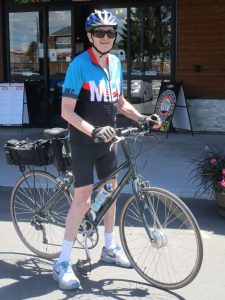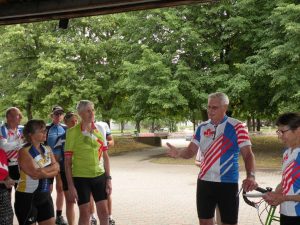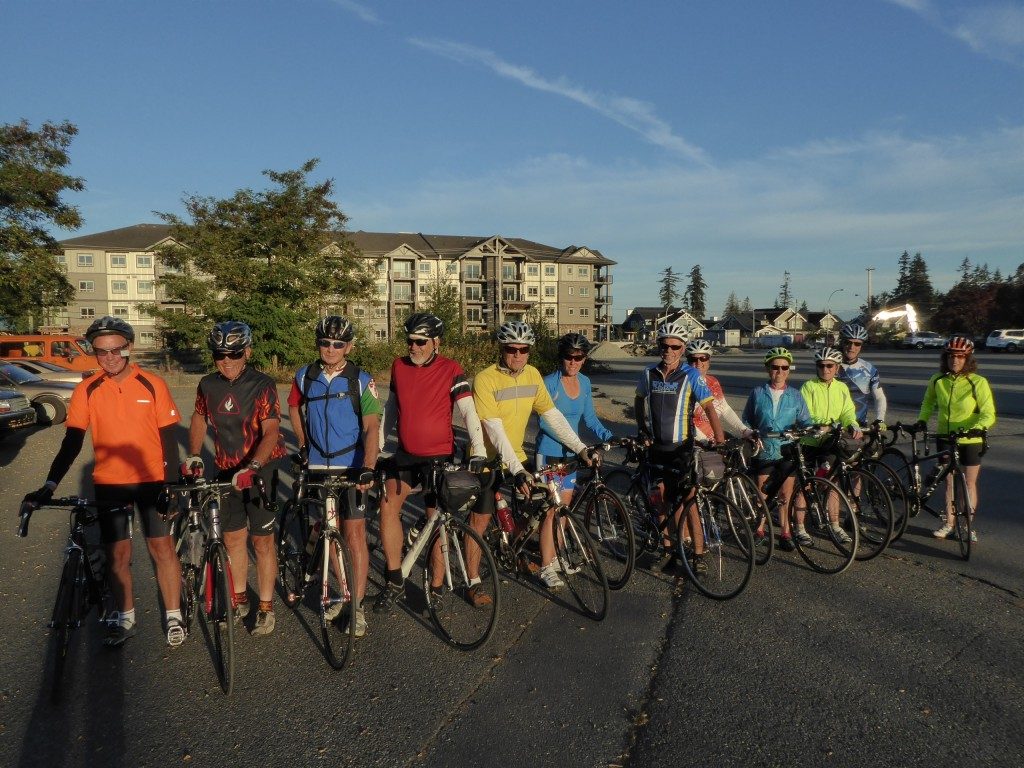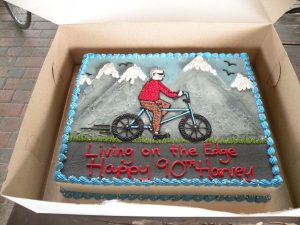The Cross Canada Cycle Tour Society September 2016, Volume 33, Issue #9
President’s Report John Pringle
Shoulder’s, Cyclists and Drivers – Can we take up the cudgel?
The two recent Southern Rockies Tours had greater than forty cyclists riding for 12 days on both the eastern and western sides of the mountains. The circular route took us from Ft. Steele, BC through Fernie and the Crowsnest Pass and then north on the Kananaskis Trail, over High Pass (Canada’s highest mountain pass) to Canmore, Banff, south to Radium and back to Fort Steele. The weather was typical summer mountain weather with frequent squalls, heavy rains, cool evenings and >30ᴼC heat. Stopping for weather conditions, for the most part, did not occur. Our ridership skills and bike quality were good and the number deploying flashing lights both front and rear was impressive.
Bruce Daykin, tour designer, kept us on small, quiet country roads where and when possible. But use of larger, busier motorways was unavoidable. Being tourist season a full range of tourist vehicles were present from very small camper vans, to large motorhomes; from vehicles pulling small tent trailers to those pulling large, and oftentimes wobbly airstream caravans. Though on vacation, these folks were often in a hurry and occasionally displayed disrespect for, and impatience with cyclists. Given these conditions my biggest concern was where to ride when shoulders were soft, rutted, grooved, gouged, broken, and generally, in poor repair. When I felt it necessary to move to the left of the white line, rarely did motorists compensate by slowing and moving leftward as well.
Nearing the end of an accident-free tour we were on hilly Route 93. Here, the hard-shoulder quality varied sharply from good to poor. Often, when poor, the adjacent lane was of equally poor quality. Vehicles were moving quickly, and often giving us little lane room to avoid the poor shoulder. I was cogitating this problem long-term i.e. what could be done to improve driver education when, just ahead, lay a bike across the shoulder, and a couple of riders tending to one of our mates. It turns out she’d gone out into the lane because of a poor shoulder. The vehicles were not giving her space and, worried, she went back to the shoulder to navigate through ruts and gouges and in so doing lost her balanced and crashed. Later hospital attendees felt she was fine and she was back on the bike next day although a month from the accident she still suffers mild vertigo. It could have been much worse.
What to do? As a Club, at least in my time as a Board member, we’ve not taken on a road a safety-cause, and maybe we should? Is driver education in BC up-to-date when it comes to dealing with cyclists? For example are most drivers aware that:
- “… the use of shoulders is optional for cyclists, who may choose not to use it for reasons such as: it being too narrow, (thereby) inviting dangerously close passes at high speed by motorists; it having a road surface unsuitable for cycling … Generally, the usable width of the road begins where one can ride without increased danger of falls, jolts or blowouts.”;
- In Ottawa “A bicycle is a vehicle and must be treated the same as buses, large trucks, motorcycles and cars. This means that cyclists need to operate their bicycles like other vehicles on the road. Motorists must also respect a cyclist’s right to ride on the street … People who ride bicycles are not obligated to use bike lanes or pathways, and are entitled to cycle on all roads …” ; And,
- advice to cyclists often is, “… the useable width of the road begins where you can ride without increased danger of falls, jolts or blowouts. A road may have a gravel shoulder, its edge may be covered with sand or trash or the pavement may be broken. Don’t ride there. Closer to the centre, there’s better pavement, which is swept clean of sand and debris … The useable road width begins here.”
As well, many cyclists are unaware of the following advice: “It may seem dangerous to make a motorist slow for you, but it’s not. The usual reason that bicyclists feel unsafe on narrow roads is that they do not take control … when drivers behind them don’t have room to pass safely. If you ride all the way to the right, you’re inviting motorists to pass you when it is unsafe and, too often, they will. If you show clearly that it’s not safe for drivers to pass you, they’re unlikely to try.”
A veteran senior rider who hung around the Velorution Bike and Ski Shop in Sault Ste Marie, Ontario told Kumiko, when we were crossing Canada, to “… ‘claim the lane’ otherwise the bastards will have you in the glass and sand of crud-filled shoulders.”
I urge that CCCTS begin a campaign to “educate BC drivers on the fact that cyclists have the right to ride on that piece of the road that is safest for them be it the shoulder or the lane.”
Welcome New Members
| David Alan | Burton | Langley | BC |
| Joanne | Moore | Pakenham | ON |
| Lynn | Robertson | Surrey | BC |
| Lesley | Beale | Vancouver | BC |
| Roger | Annis | Vancouver | BC |
| Carol | Campbell | Vancouver | BC |
| Ritchie | Baggs | Victoria | BC |
Meet Our Members
Sunseekers, frequent flyers, cycle lovers or all of these!
People cycle to stay active, travel the world, have fun, or as their mode of transport. Some even meet the love of their life cycling. I noticed some of these couples within the club and it got me thinking, how does that happen?
Well, to quote 3 couples, “We met cycling!” And they continue to cycle together and apart. Some are km./miles apart, literally. Burnaby, B.C. and Tacoma, WA, North Vancouver, B.C. and Albuquerque, NM or Langley, B.C. and Australia. (Bet they know the rules about tax implications, medical coverage, booking cheap airfares and the Can. $ exchange rates.)
Logistics vary, part of each week together, or together depending on plans or 6 months at each home. Bikes and cycling clothes in each location usually. Life is active year round for all!
Starting with the most recent pair, Charlene Doward (Burnaby) and Bob Myrick (Tacoma) met 3 years ago on a club trip in Arizona. They tend to see each other for a few days each week, commuting between their homes. (About 3 hours driving.) Charlene still works part time and is the Hub & Spoke Coordinator for the club. Bob is president of the Mt. Tahoma Trails Assoc., works with Tacoma Wheelman’s Bicycle Club and is active in building bike trails. They enjoy time together, but also enjoy their separate interests.
They do cycle trips with CCCTS and BAC as well as adventures on their own or with friends, They x-c ski and do fat tire bike trips in the winter.
Favorite cycle trips: Charlene – Croatia 2012, Bob – tour de France Hills (sounds gruelling) and the Lewis & Clarke Trail solo.
Marjorie Miller, (80 km.S of Perth, Australia) and Ted Witt (Langley) are experienced long term commuters after 11 years. They met at a bicycle club in Mandurah, West Australia in 2005. Both enjoy cycling and their lives are very bike oriented. They house sit extensively in Australia, spending 6 months there and 6 months in Canada. “We thus have 6 months of summer, 4 months of spring, 2 months of autumn and zero months of winter every year” Now that’s planning. Not sure about the commuting time, 25 hours plus flight times.
They live double lives- 2 bikes each in each location and 2 cycle clubs as well as CCCTS in Canada. Marjorie is recovering from a bike accident, but despite that on a recent Wed. ride of 73 km. they commuted by bike to the start, adding another 30 km. to the total
When asked about managing a long distance relationship, they feel they have a short distance relationship, it’s either Canada or Australia, together!
Holly Evans (North Vancouver) and Ken Levine (Albuquerque) are more flexible about their lives together and apart. They split the distance with 2 months in Oceanside, CA. (They hosted a recent club Hub & Spoke this Jan. 2016) or spend 4-6 weeks at either location. They are masters of the math, maximum 180 days per year out of their home country. They met at the Santa Fe Trail Bicycle Trek in 1997, so they have experience.
Like the other couples, they have gear in both places. Clothes, multiple bikes, snowshoes, backpacks and more. They are active year round, involved in 2 bike clubs as well as CCCTS, hiking clubs and active senior groups, often in leadership roles. They are both on the CCCTS executive. Add gardening for Holly and swimming and family in NY for Ken. Commute time flights 5-8 hours.
Favourite trips: Holly- Vietnam with CCCTS, for Ken- China, Vietnam and India. For both – self supported trips in Europe, Canada & the USA.
They appreciate the connections and friends in both locations, the challenge is to maintain those wonderful connections.
Ken’s parting advice- Keep the bike tires inflated and moving, regardless of one’s ability as we age, just keep riding.
My take away, what a great way to travel and always be home with someone you love! And you can have a good reason for more bikes!
Ps. If you have any suggestions for future “member profiles” please forward them to the CCCTS office.
CCCTS Ottawa Branch Member Turns 90!
It was back in 2009, when on a Thursday ride on the Rideau River Road, I noticed a rider was getting a little restless. Since I was the leader, he asked if I would mind if he rode ahead to where the cars were parked. To my surprise he was out of site on no time. When I commented to another rider how strong a cyclist he was I was told that he was 82 or 83 years old. Knowing he was 9 years older than me I had to know “how come” he was such a capable cyclist. He came back with the answer, “never in my life was I not fit”. Not I have been fit all my life, but “never in my life was I not fit”. I think you will agree, the words say the same thing but the meaning is significantly different. This was my first insight into Harvie Cocks. 
My next encounter with Harvie was on another ride, when we were having a picnic lunch in Carp, I told him of a trip I had planned called the Hudson Valley Pedal from Albany N.Y to New York City. My second insight into Harvie is how he can get all the details out of you. It is not quite an interrogation but close. When I told him we would be crossing the George Washington bridge, and cycling along the Hudson River I realized he was hooked. I gave him the Web site of the tour but was not sure what to expect. I was not home more than an hour or two, however, when I got a phone call to tell me that he was registered so we could go together. This was my second insight into Harvie. He can make decisions and move fast if he needs to.
So we planned the trip and since it was camping, Harvie suggested we could share a two man tent. Up to then I had not known Harvie well but I also knew that would change since we were to share not only the trip but also, what would become the famous, two man tent. The trip did go well and I was able to keep up to Harvie on the flat but when it came to hills he just pulled ahead of me. I usually found him waiting for me at the next rest stop in conversation with the youngest and prettiest girl there. This was my third insight into Harvie.
After the trip we both agreed that two old farts, that need a pee break at least once and sometimes twice during the night, would not be sharing a tent again. Since then we have shared a few hub and spokes and with luck more in the future.
Today I have been given the pleasure to honour Harvey for his 21 years as a club member and also for turning 90 on July 27THof this year. Put your hands together for our oldest club member and for his 21 years with CCCTS.
Submitted by Ottawa Branch member, Jack Fallis
Eighth Annual Century Ride a Success
Just after dawn on a beautiful, clear late August day, 12 riders headed out on the seventh annual Claire’s Classic Century Ride challenge. It’s 162.5 km (100 miles) in length and in three loops which crisscross Langley from top to bottom and left to right. Some stuck it out for one loop, some for two, and seven of us for the entire three loops. Wind picked up and clouds rolled in by mid-day, but our intrepid band kept rolling along.
Congratulations to all, and especially finishers Carol and Glen Evans, Monica Zack, Sue Bunten, Eric Brown, David Liggat and Chris Hodgson. All were rewarded at the finish line with apple cider, craft beer and piña colada. After the refreshments saddle sores were forgotten and all agreed that a very good time was had by all.
New Hub & Spoke and Trip Report
- Italy Apennines Tour 2016
- Glaciers and Grasslands Double Hub & Spoke
- Southern Rockies Tour #2 2016 The Rainy Ride
- Okanagan Hub and Spoke
- Southern Rockies Tour #1 2016
- Vancouver Hub and Spoke

